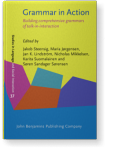Chapter 13
Other-extensions in Italian
A case of and for
Collaborative Grammar
This chapter focuses on the practice of other-extending a
prior speaker’s complete turn in Italian. By drawing on the
grammatical formatting and/or reusing elements in prior turns to
extend them, speakers deploy Collaborative Grammar (Calabria 2022), a set of
grammatical formats and resources available in a language to design
turns to be heard as grammatically integrated. Using Conversation
Analysis and Interactional Linguistics, three actions are identified
that speakers achieve by other-extending in Italian multiperson
interactions: providing additional information, verifying while
demonstrating understanding, and reframing prior talk as laughable.
This chapter argues that practices implemented with Collaborative
Grammar between multiple speakers should constitute a dedicated
section in a comprehensive grammar that aims at describing the
competing temporalities of multiperson interactions.
Article outline
- 1.Introduction
- 2.Incrementing talk with other-extensions
- 3.Data and methods
- 4.Analyses
- 4.1Other-incrementing and providing additional
information
- 4.2Verifying while demonstrating understanding
- 4.3Reframing prior talk as laughable
- 5.Discussion
- 6.Conclusion
-
Notes
-
References
This content is being prepared for publication; it may be subject to changes.
